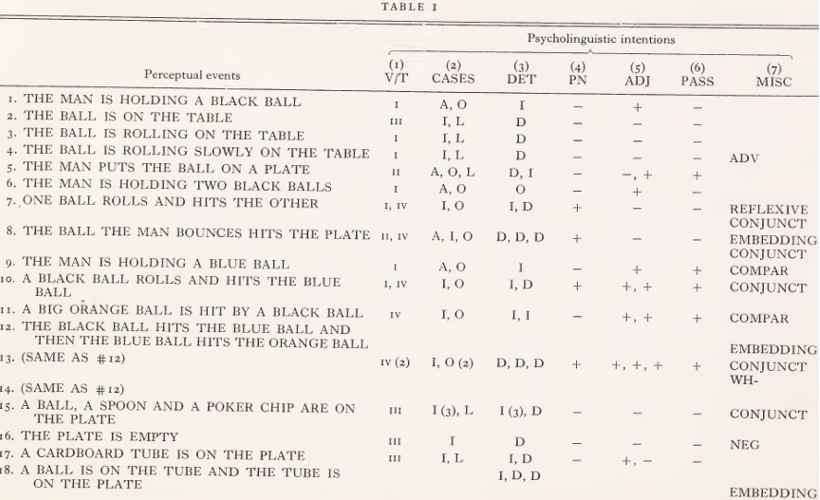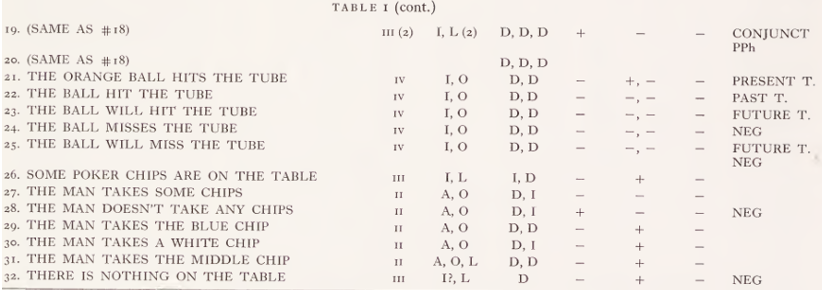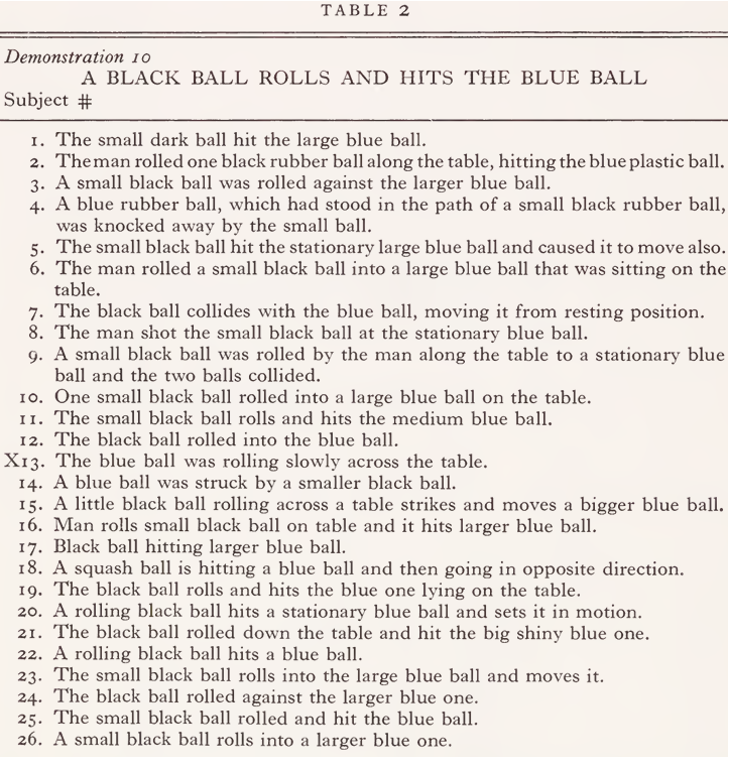


 Grammar
Grammar
 Tenses
Tenses
 Present
Present
 Past
Past
 Future
Future
 Parts Of Speech
Parts Of Speech
 Nouns
Nouns
 Verbs
Verbs
 Adverbs
Adverbs
 Adjectives
Adjectives
 Pronouns
Pronouns
 Pre Position
Pre Position
 Preposition by function
Preposition by function 
 Preposition by construction
Preposition by construction
 Conjunctions
Conjunctions
 Interjections
Interjections
 Grammar Rules
Grammar Rules
 Linguistics
Linguistics
 Semantics
Semantics
 Pragmatics
Pragmatics
 Reading Comprehension
Reading Comprehension|
Read More
Date: 2023-03-24
Date: 2024-08-20
Date: 2023-04-20
|
In the fall of 1968 I arranged this demonstration-experiment for 26 native speakers of English.1 A sequence of 32 ‘scenes’ were presented, preceded by the following instructions: ‘ Start each numbered item (1-32) with your eyes closed; when I say ‘open’ observe what is transpiring and then close your eyes when I say ‘close’; describe in a single sentence just what you see while your eyes are open; imagine that you are describing things for a hypothetical six-year-old child standing behind a hypothetical screen - that is, use simple ordinary language, not fancy scientific or philosophical jargon; refer to me as the man and to other objects and events as you see fit. Any questions? All right, close your eyes and get ready for #1.’ Ideally, of course, these perceptual ‘ scenes ’ should have been prepared on color film, and this will be done for cross-cultural studies with children of various ages that we are planning.
For convenience in discussion, I will refer to the various objects used in the demonstrations (including myself as THE MAN) as entities (perceptual signs analogous to ‘words’) and to the interactions and relations produced among these perceived entities as events (perceptual structures analogous to ‘sentences’). Table 1 presents the sequence of perceptual events2 along with the psycholinguistic intentions presumably involved - both my intentions as the experimenter and, if successful, the encoding intentions of the subjects created by the perceptual inputs. These intentions are the predictions being made in this experiment, and the sentences compared in testing them will be detailed in course. Needless to say, I ordered the sequence of perceptual events with presuppositional ‘malice aforethought’; for example, #3 (THE BALL IS ROLLING ON THE TABLE) followed by #4 (THE BALL IS ROLLING SLOWLY ON THE TABLE) or # 15 (A BALL, A SPOON AND A POKER CHIP ARE ON THE PLATE) followed by #16 (THE PLATE IS EMPTY).
Note that events #12, #13 and #14 (THE BLACK BALL HITS THE BLUE BALL AND THEN THE BLUE BALL HITS THE ORANGE BALL) were actually only performed once, with the subjects asked ‘to describe it in a different sentence’ (#13) and then ‘in yet a different sentence’ (# 14); the same applies to events #18 through #20 (THE BALL IS ON THE TUBE AND THE TUBE IS ON THE PLATE). These two demonstrations were designed to get at surface transformations of the same perceptually-anchored deep or semantic structure within the same speaker as well as across speakers (which occurs for every demonstration). While the subjects were writing their sentences I prepared for the next event, but nothing was done or placed on the table until they had closed their eyes.
Although the major purpose in this little experiment was to demonstrate the influence of perceptual presuppositions upon the form of sentences, there was also very obvious (but not trivial) influence of perceptual input upon the lexical content of sentences. Table 2 presents the 26 sentences produced by Event # 10 (A BLACK BALL ROLLS AND HITS THE BLUE BALL).3 We note that every speaker with a single exception encodes both a black ball and blue ball in his sentence (no poker chips, tubes or plates), the former indicated as Actor (Instrumental case) and the latter as Recipient (Objective case). The one exception (marked X, subject #13) apparently opened her eyes too late! Similarly for event # 15 (A BALL, A SPOON AND A POKER CHIP ARE ON THE PLATE), although the lexical items selected varied somewhat (e.g., chip vs. disc) as did the presence of qualifying adjectives, all subjects but two refer to all four entities and the proper relation of the plate (lid, dish, ashtray, etc.) to the other three.


The two exceptions were apparently fixated on only the ball in the plate. Also obvious is the influence of perceiving two or more entities of the same nominal class upon producing plurals, specifically in #6 where all but two subjects refer to two balls and in #26, 27 and 28 where all speakers without exceptions use the plural )chips, discs, buttons). One could quite correctly say ‘ what else could they say? ’ when constrained by these perceptual events.

The general procedure for testing specific predictions about the effects of perceptual events upon the forms of sentences describing them will be to compare the sets of sentences generated by those events in which a given presupposition is assumed to be operating with sets of sentences where it is not. The latter ‘ control ’ events will be matched as closely as possible in other respects. For example, it is predicted that an action involving two categorically identical objects (#7, where one black ball rolls and hits another) will have a higher probability of generating a reflexive form than a control event involving two categorically different objects (# 10, where a black ball rolls and hits the blue ball); thus event #10 serves as a control for event #7 with respect to this particular prediction (it may have other functions with respect to other predictions). The results of the tests will be expressed in simple percentages, finer statistical manipulations being unnecessary for present purposes.
In a chapter of his Linguistics in Philosophy (1967) bearing this title, Zeno Vendler derives a two-feature system for English verbs with respect to the time dimension. The supraordinate feature is Action vs. State: one can say significantly I am PUSHING it (Action verb), but it is strange to say I am KNOWING it (State verb). The subordinate feature is Interminal vs. Terminal (my terms, not Vendler’s): one can reasonably ask for how long did you PUSH? (Interminal Action Verb) and how long did it take you to DRESS? (Terminal Action verb), but hardly the converse questions, for how long did you DRESS? or how long did it take you to PUSH?; and similarly for State verbs, for how long did you know the girl? (Interminal State verb) and at what time did you MEET the girl? (Terminal State verb), but hardly the converse, for how long did you MEET the girl? In column (1) of Table 1 all of the perceptual events are assigned to these four Vendler categories, Interminal Action events, 1 (e.g., THE MAN IS HOLDING A BALL), Terminal Action events, 11 (e.g., THE MAN PUTS THE BALL ON A PLATE), Interminal State events, 111 (e.g., THE BALL IS ON THE TABLE), and Terminal State events, IV (e.g., THE BALL HITS THE TUBE).
Two types of sentential phemonema (here, lexical) were predicted: (1) that usage of forms of the verb to be, either as auxiliary (is holding) or alone (is on the table),4 would be relatively more frequent (a) for Stative than for Action perceptual events and (b) for Interminal than for Terminal events; (2) that usage of the present tense relative to the past tense would be greater for Interminal than for Terminal per¬ ceptual events. In demonstrations where two events were involved (e.g., ONE BALL ROLLS AND HITS ANOTHER), the verb phrases for each were considered separately. Table 3 summarizes the results over all 32 demonstrations. As can be seen the effect of Interminal as compared with Terminal events upon producing usage of both the verb to be and the present tense rather than the past is marked, particularly the former (Terminal events very rarely are encoded with to be forms, e.g., the ball is hitting the pole). Stative events produce slightly more to be and present tense verbs than Action, but the differences would not be significant. In any case, we can conclude that events which are perceived as on-going (Interminal) tend to be encoded as existing in the subjective present as compared with events perceived as completed (Terminal), which tend to be encoded as being in the past and no longer existing.

1 Subjects 1-9 were staff and graduate assistants in the Center for Comparative Psycholinguistics; subjects 10-26 were graduate students in my seminar on psycholinguistics. Several people who are native speakers of a language other than English participated, but they did their describing in their own native language and their data were not included for present purposes.
2 Although the wordings of these events in Table 1 were largely descriptive, to serve as my own guide in executing the demonstrations, they also reflect to some extent my own intentions, e.g., #7 ONE BALL ROLLS AND HITS THE OTHER (reflexive), # 8 THE BALL THE MAN BOUNCES HITS THE PLATE (center-embedding).
3 Space does not permit inclusion of the sentences produced in all 32 demonstrations. These raw data can be obtained from the author on request.
4 Occurrences of forms of to be in passive constructions were not counted, since the is in the passive form is hit by is part of an obligatory transformation and is certainly not semantically equivalent to the is in the active is hitting.
|
|
|
|
علامات بسيطة في جسدك قد تنذر بمرض "قاتل"
|
|
|
|
|
|
|
أول صور ثلاثية الأبعاد للغدة الزعترية البشرية
|
|
|
|
|
|
|
معهد الكفيل للنطق والتأهيل: أطلقنا برامج متنوعة لدعم الأطفال وتعزيز مهاراتهم التعليمية والاجتماعية
|
|
|